University Article Critique: Sedentary Behavior and Cancer Study
VerifiedAdded on 2022/08/20
|6
|1330
|25
Report
AI Summary
This report presents a comprehensive critique of the research article titled "Physical and psychological health among breast cancer survivors: interactions with sedentary behavior and physical activity." The study investigated the relationship between sedentary behavior, physical activity levels, and symptoms of fatigue, pain, and depression in breast cancer survivors. The research employed a longitudinal study design, recruiting participants through local advertisements and referrals. The findings revealed that a significant portion of the participants did not meet physical activity guidelines, and increased sedentary behavior correlated with increased symptoms of fatigue, pain, and depression. The authors concluded that higher levels of physical activity are crucial for mitigating these negative outcomes. The critique analyzes the study's purpose, hypotheses, methodology, results, and limitations, including the potential for biased sampling and the influence of other factors on participant behavior. The report also discusses the study's internal and external validity, providing a detailed evaluation of the research's strengths and weaknesses.
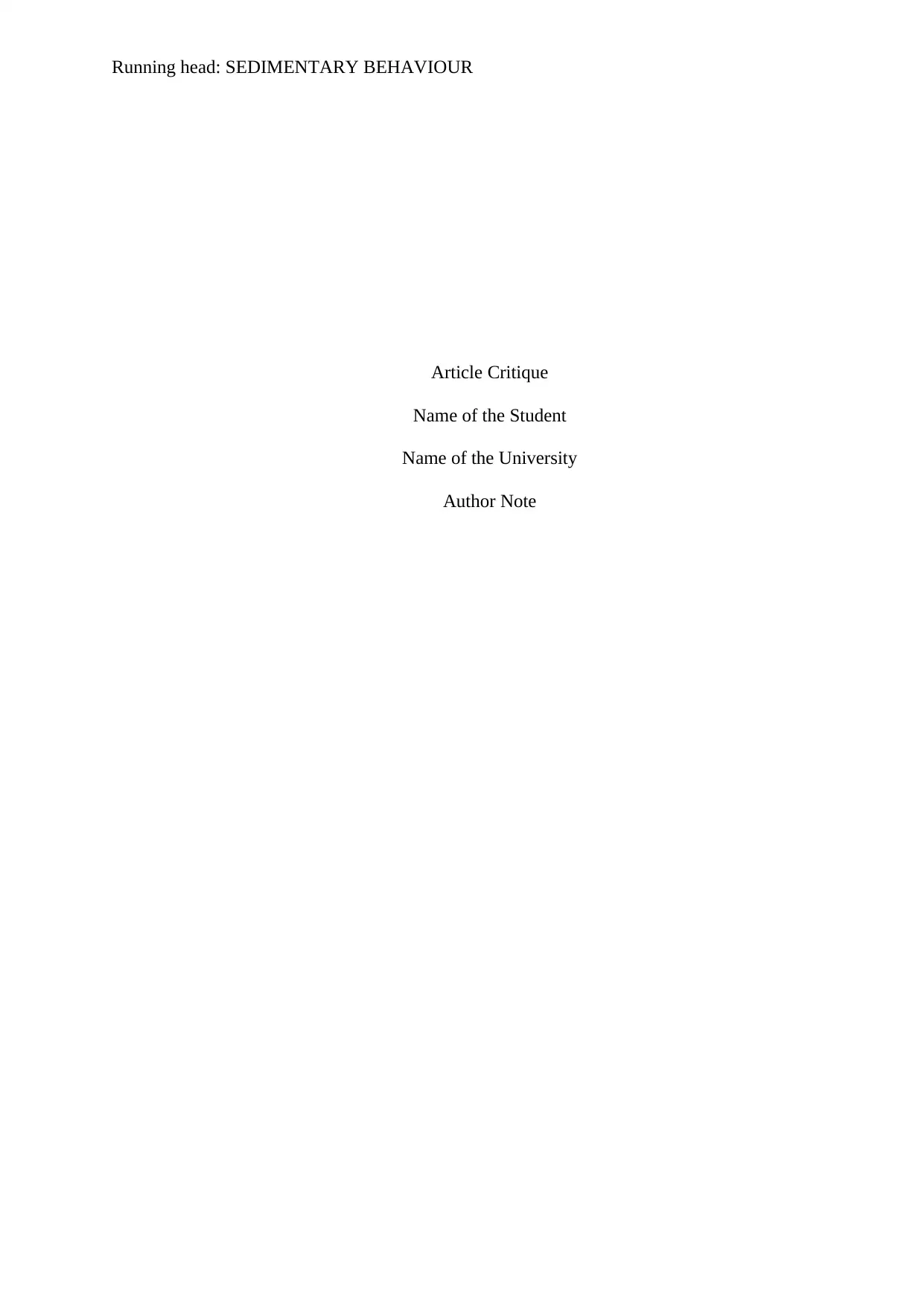
Running head: SEDIMENTARY BEHAVIOUR
Article Critique
Name of the Student
Name of the University
Author Note
Article Critique
Name of the Student
Name of the University
Author Note
Paraphrase This Document
Need a fresh take? Get an instant paraphrase of this document with our AI Paraphraser
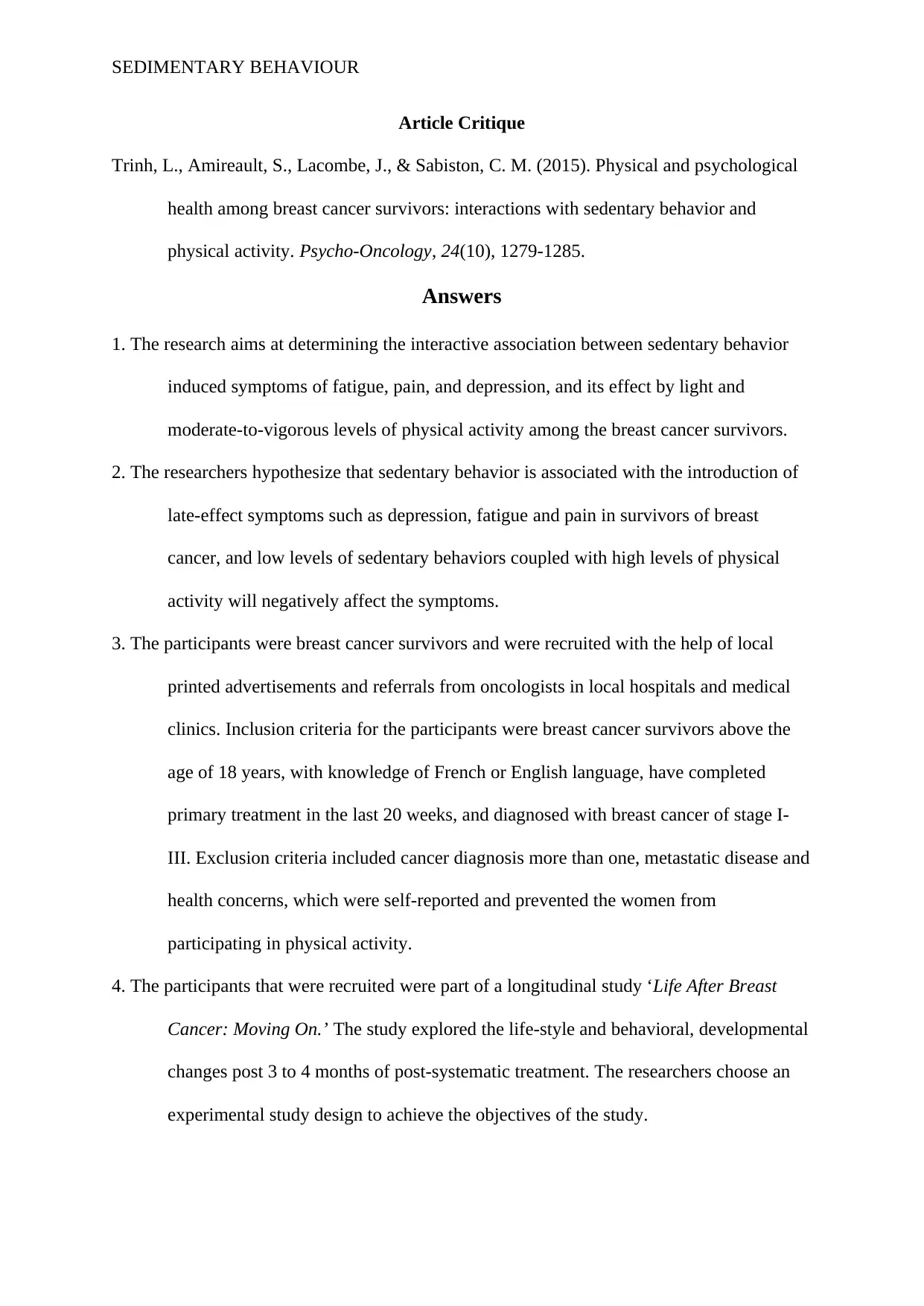
SEDIMENTARY BEHAVIOUR
Article Critique
Trinh, L., Amireault, S., Lacombe, J., & Sabiston, C. M. (2015). Physical and psychological
health among breast cancer survivors: interactions with sedentary behavior and
physical activity. Psycho‐Oncology, 24(10), 1279-1285.
Answers
1. The research aims at determining the interactive association between sedentary behavior
induced symptoms of fatigue, pain, and depression, and its effect by light and
moderate-to-vigorous levels of physical activity among the breast cancer survivors.
2. The researchers hypothesize that sedentary behavior is associated with the introduction of
late-effect symptoms such as depression, fatigue and pain in survivors of breast
cancer, and low levels of sedentary behaviors coupled with high levels of physical
activity will negatively affect the symptoms.
3. The participants were breast cancer survivors and were recruited with the help of local
printed advertisements and referrals from oncologists in local hospitals and medical
clinics. Inclusion criteria for the participants were breast cancer survivors above the
age of 18 years, with knowledge of French or English language, have completed
primary treatment in the last 20 weeks, and diagnosed with breast cancer of stage I-
III. Exclusion criteria included cancer diagnosis more than one, metastatic disease and
health concerns, which were self-reported and prevented the women from
participating in physical activity.
4. The participants that were recruited were part of a longitudinal study ‘Life After Breast
Cancer: Moving On.’ The study explored the life-style and behavioral, developmental
changes post 3 to 4 months of post-systematic treatment. The researchers choose an
experimental study design to achieve the objectives of the study.
Article Critique
Trinh, L., Amireault, S., Lacombe, J., & Sabiston, C. M. (2015). Physical and psychological
health among breast cancer survivors: interactions with sedentary behavior and
physical activity. Psycho‐Oncology, 24(10), 1279-1285.
Answers
1. The research aims at determining the interactive association between sedentary behavior
induced symptoms of fatigue, pain, and depression, and its effect by light and
moderate-to-vigorous levels of physical activity among the breast cancer survivors.
2. The researchers hypothesize that sedentary behavior is associated with the introduction of
late-effect symptoms such as depression, fatigue and pain in survivors of breast
cancer, and low levels of sedentary behaviors coupled with high levels of physical
activity will negatively affect the symptoms.
3. The participants were breast cancer survivors and were recruited with the help of local
printed advertisements and referrals from oncologists in local hospitals and medical
clinics. Inclusion criteria for the participants were breast cancer survivors above the
age of 18 years, with knowledge of French or English language, have completed
primary treatment in the last 20 weeks, and diagnosed with breast cancer of stage I-
III. Exclusion criteria included cancer diagnosis more than one, metastatic disease and
health concerns, which were self-reported and prevented the women from
participating in physical activity.
4. The participants that were recruited were part of a longitudinal study ‘Life After Breast
Cancer: Moving On.’ The study explored the life-style and behavioral, developmental
changes post 3 to 4 months of post-systematic treatment. The researchers choose an
experimental study design to achieve the objectives of the study.
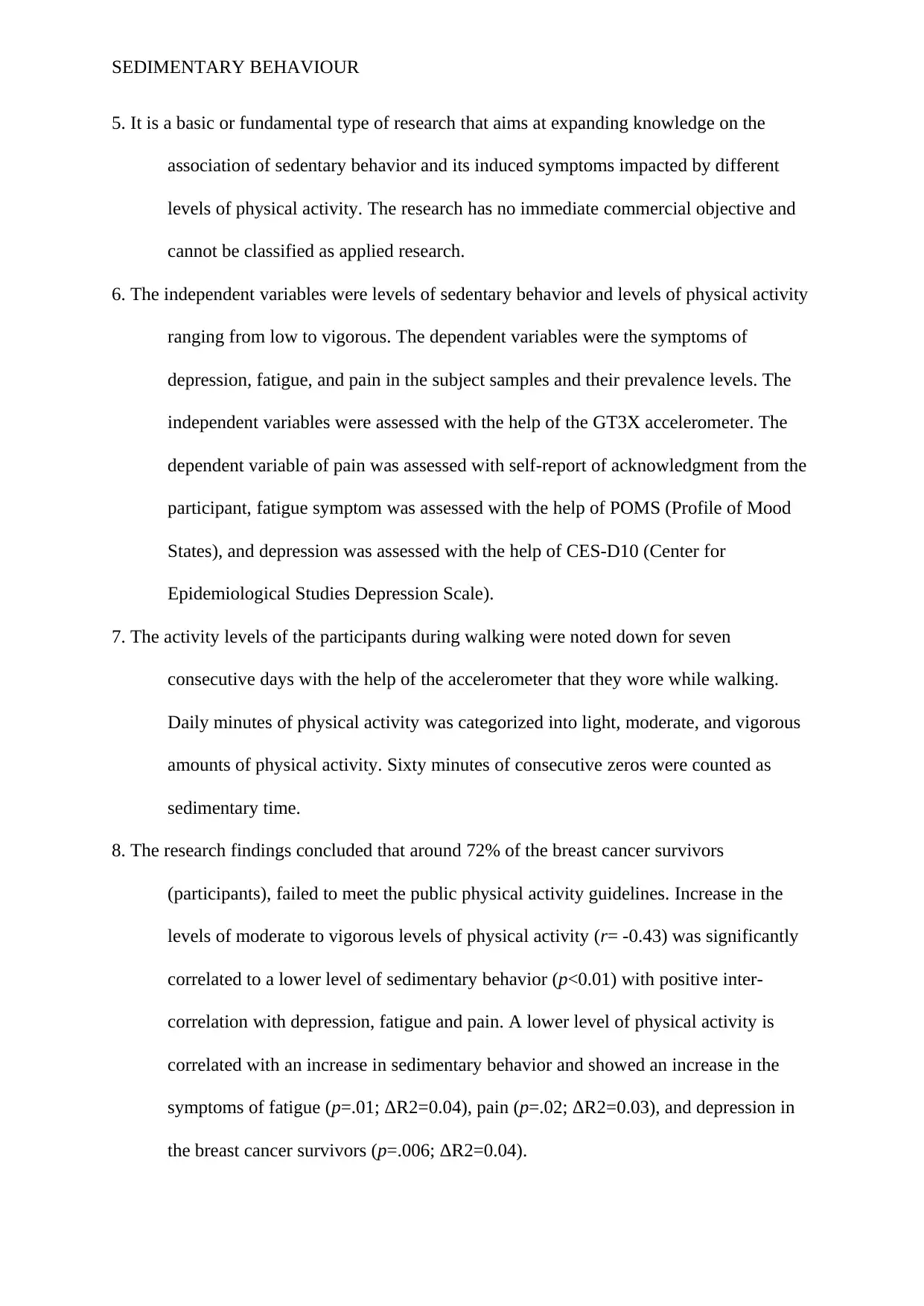
SEDIMENTARY BEHAVIOUR
5. It is a basic or fundamental type of research that aims at expanding knowledge on the
association of sedentary behavior and its induced symptoms impacted by different
levels of physical activity. The research has no immediate commercial objective and
cannot be classified as applied research.
6. The independent variables were levels of sedentary behavior and levels of physical activity
ranging from low to vigorous. The dependent variables were the symptoms of
depression, fatigue, and pain in the subject samples and their prevalence levels. The
independent variables were assessed with the help of the GT3X accelerometer. The
dependent variable of pain was assessed with self-report of acknowledgment from the
participant, fatigue symptom was assessed with the help of POMS (Profile of Mood
States), and depression was assessed with the help of CES-D10 (Center for
Epidemiological Studies Depression Scale).
7. The activity levels of the participants during walking were noted down for seven
consecutive days with the help of the accelerometer that they wore while walking.
Daily minutes of physical activity was categorized into light, moderate, and vigorous
amounts of physical activity. Sixty minutes of consecutive zeros were counted as
sedimentary time.
8. The research findings concluded that around 72% of the breast cancer survivors
(participants), failed to meet the public physical activity guidelines. Increase in the
levels of moderate to vigorous levels of physical activity (r= -0.43) was significantly
correlated to a lower level of sedimentary behavior (p<0.01) with positive inter-
correlation with depression, fatigue and pain. A lower level of physical activity is
correlated with an increase in sedimentary behavior and showed an increase in the
symptoms of fatigue (p=.01; ΔR2=0.04), pain (p=.02; ΔR2=0.03), and depression in
the breast cancer survivors (p=.006; ΔR2=0.04).
5. It is a basic or fundamental type of research that aims at expanding knowledge on the
association of sedentary behavior and its induced symptoms impacted by different
levels of physical activity. The research has no immediate commercial objective and
cannot be classified as applied research.
6. The independent variables were levels of sedentary behavior and levels of physical activity
ranging from low to vigorous. The dependent variables were the symptoms of
depression, fatigue, and pain in the subject samples and their prevalence levels. The
independent variables were assessed with the help of the GT3X accelerometer. The
dependent variable of pain was assessed with self-report of acknowledgment from the
participant, fatigue symptom was assessed with the help of POMS (Profile of Mood
States), and depression was assessed with the help of CES-D10 (Center for
Epidemiological Studies Depression Scale).
7. The activity levels of the participants during walking were noted down for seven
consecutive days with the help of the accelerometer that they wore while walking.
Daily minutes of physical activity was categorized into light, moderate, and vigorous
amounts of physical activity. Sixty minutes of consecutive zeros were counted as
sedimentary time.
8. The research findings concluded that around 72% of the breast cancer survivors
(participants), failed to meet the public physical activity guidelines. Increase in the
levels of moderate to vigorous levels of physical activity (r= -0.43) was significantly
correlated to a lower level of sedimentary behavior (p<0.01) with positive inter-
correlation with depression, fatigue and pain. A lower level of physical activity is
correlated with an increase in sedimentary behavior and showed an increase in the
symptoms of fatigue (p=.01; ΔR2=0.04), pain (p=.02; ΔR2=0.03), and depression in
the breast cancer survivors (p=.006; ΔR2=0.04).
⊘ This is a preview!⊘
Do you want full access?
Subscribe today to unlock all pages.

Trusted by 1+ million students worldwide
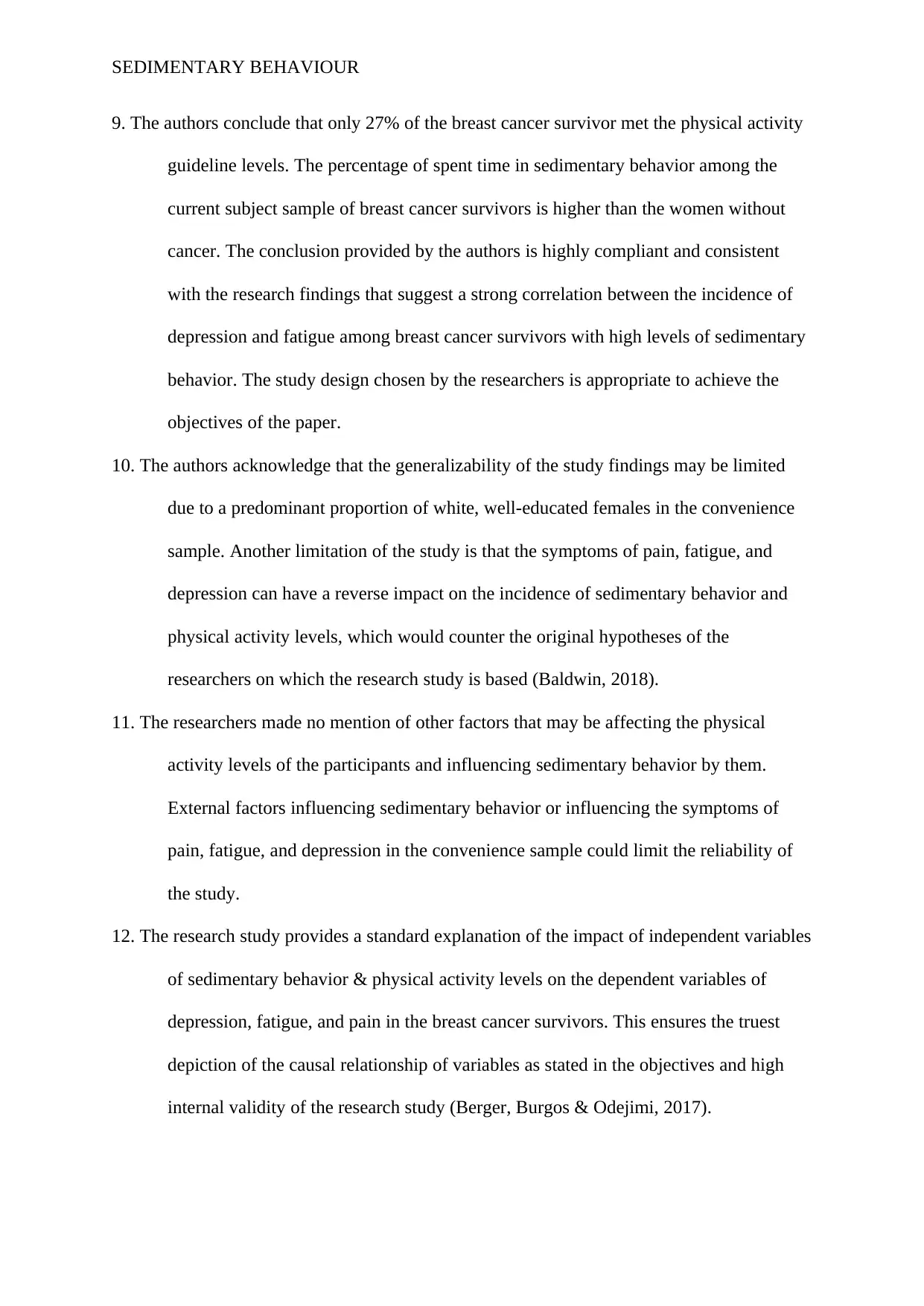
SEDIMENTARY BEHAVIOUR
9. The authors conclude that only 27% of the breast cancer survivor met the physical activity
guideline levels. The percentage of spent time in sedimentary behavior among the
current subject sample of breast cancer survivors is higher than the women without
cancer. The conclusion provided by the authors is highly compliant and consistent
with the research findings that suggest a strong correlation between the incidence of
depression and fatigue among breast cancer survivors with high levels of sedimentary
behavior. The study design chosen by the researchers is appropriate to achieve the
objectives of the paper.
10. The authors acknowledge that the generalizability of the study findings may be limited
due to a predominant proportion of white, well-educated females in the convenience
sample. Another limitation of the study is that the symptoms of pain, fatigue, and
depression can have a reverse impact on the incidence of sedimentary behavior and
physical activity levels, which would counter the original hypotheses of the
researchers on which the research study is based (Baldwin, 2018).
11. The researchers made no mention of other factors that may be affecting the physical
activity levels of the participants and influencing sedimentary behavior by them.
External factors influencing sedimentary behavior or influencing the symptoms of
pain, fatigue, and depression in the convenience sample could limit the reliability of
the study.
12. The research study provides a standard explanation of the impact of independent variables
of sedimentary behavior & physical activity levels on the dependent variables of
depression, fatigue, and pain in the breast cancer survivors. This ensures the truest
depiction of the causal relationship of variables as stated in the objectives and high
internal validity of the research study (Berger, Burgos & Odejimi, 2017).
9. The authors conclude that only 27% of the breast cancer survivor met the physical activity
guideline levels. The percentage of spent time in sedimentary behavior among the
current subject sample of breast cancer survivors is higher than the women without
cancer. The conclusion provided by the authors is highly compliant and consistent
with the research findings that suggest a strong correlation between the incidence of
depression and fatigue among breast cancer survivors with high levels of sedimentary
behavior. The study design chosen by the researchers is appropriate to achieve the
objectives of the paper.
10. The authors acknowledge that the generalizability of the study findings may be limited
due to a predominant proportion of white, well-educated females in the convenience
sample. Another limitation of the study is that the symptoms of pain, fatigue, and
depression can have a reverse impact on the incidence of sedimentary behavior and
physical activity levels, which would counter the original hypotheses of the
researchers on which the research study is based (Baldwin, 2018).
11. The researchers made no mention of other factors that may be affecting the physical
activity levels of the participants and influencing sedimentary behavior by them.
External factors influencing sedimentary behavior or influencing the symptoms of
pain, fatigue, and depression in the convenience sample could limit the reliability of
the study.
12. The research study provides a standard explanation of the impact of independent variables
of sedimentary behavior & physical activity levels on the dependent variables of
depression, fatigue, and pain in the breast cancer survivors. This ensures the truest
depiction of the causal relationship of variables as stated in the objectives and high
internal validity of the research study (Berger, Burgos & Odejimi, 2017).
Paraphrase This Document
Need a fresh take? Get an instant paraphrase of this document with our AI Paraphraser
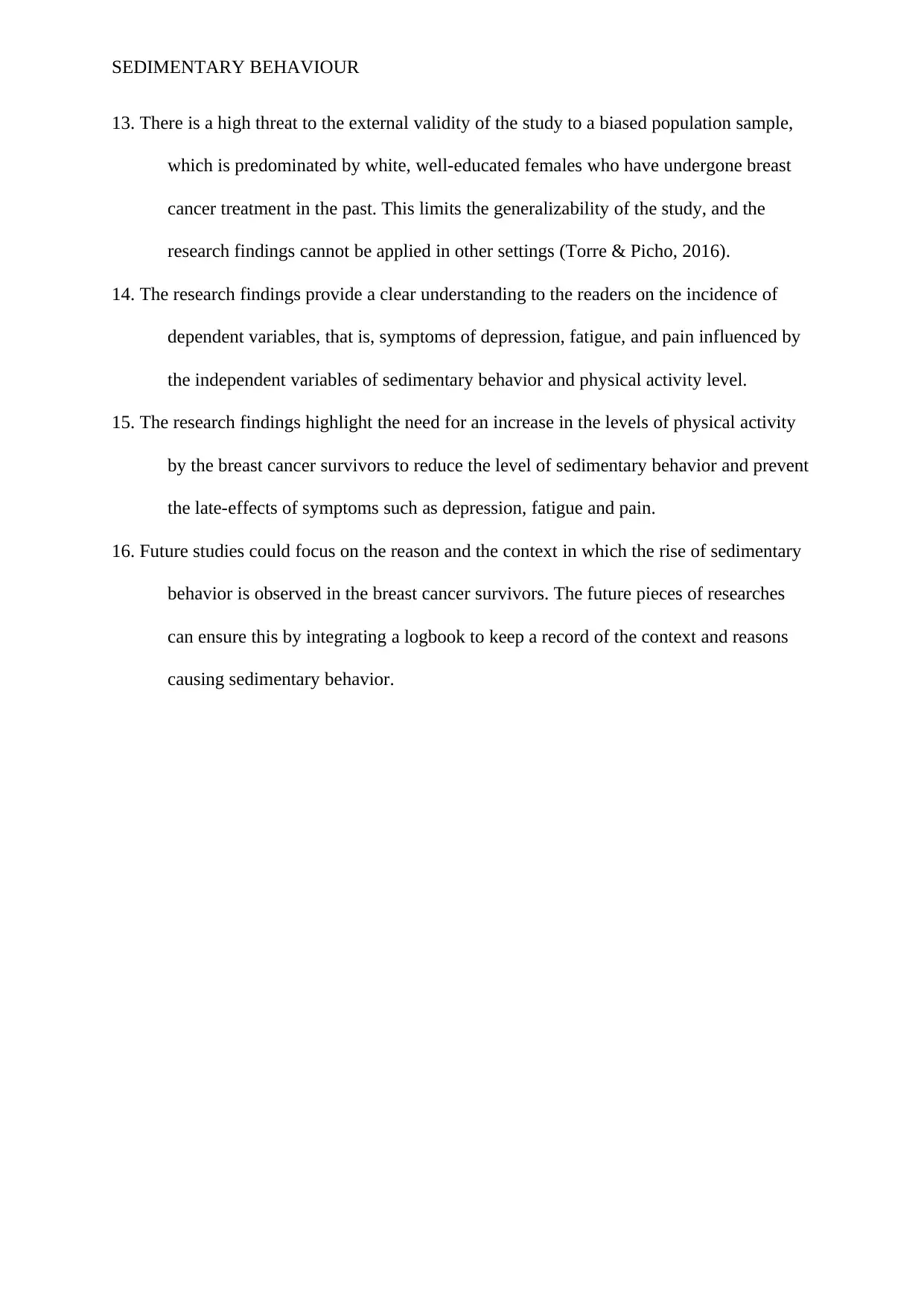
SEDIMENTARY BEHAVIOUR
13. There is a high threat to the external validity of the study to a biased population sample,
which is predominated by white, well-educated females who have undergone breast
cancer treatment in the past. This limits the generalizability of the study, and the
research findings cannot be applied in other settings (Torre & Picho, 2016).
14. The research findings provide a clear understanding to the readers on the incidence of
dependent variables, that is, symptoms of depression, fatigue, and pain influenced by
the independent variables of sedimentary behavior and physical activity level.
15. The research findings highlight the need for an increase in the levels of physical activity
by the breast cancer survivors to reduce the level of sedimentary behavior and prevent
the late-effects of symptoms such as depression, fatigue and pain.
16. Future studies could focus on the reason and the context in which the rise of sedimentary
behavior is observed in the breast cancer survivors. The future pieces of researches
can ensure this by integrating a logbook to keep a record of the context and reasons
causing sedimentary behavior.
13. There is a high threat to the external validity of the study to a biased population sample,
which is predominated by white, well-educated females who have undergone breast
cancer treatment in the past. This limits the generalizability of the study, and the
research findings cannot be applied in other settings (Torre & Picho, 2016).
14. The research findings provide a clear understanding to the readers on the incidence of
dependent variables, that is, symptoms of depression, fatigue, and pain influenced by
the independent variables of sedimentary behavior and physical activity level.
15. The research findings highlight the need for an increase in the levels of physical activity
by the breast cancer survivors to reduce the level of sedimentary behavior and prevent
the late-effects of symptoms such as depression, fatigue and pain.
16. Future studies could focus on the reason and the context in which the rise of sedimentary
behavior is observed in the breast cancer survivors. The future pieces of researches
can ensure this by integrating a logbook to keep a record of the context and reasons
causing sedimentary behavior.
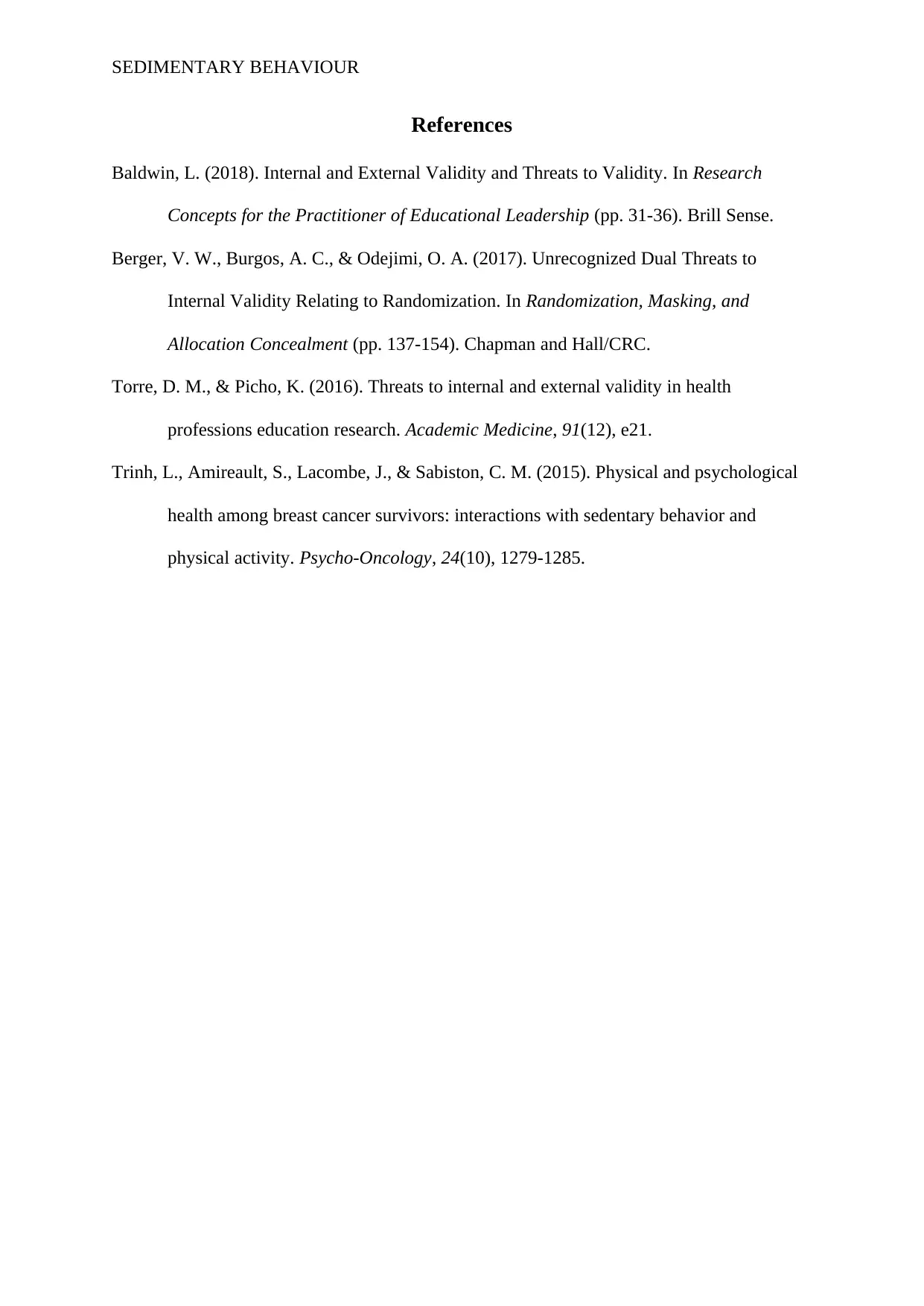
SEDIMENTARY BEHAVIOUR
References
Baldwin, L. (2018). Internal and External Validity and Threats to Validity. In Research
Concepts for the Practitioner of Educational Leadership (pp. 31-36). Brill Sense.
Berger, V. W., Burgos, A. C., & Odejimi, O. A. (2017). Unrecognized Dual Threats to
Internal Validity Relating to Randomization. In Randomization, Masking, and
Allocation Concealment (pp. 137-154). Chapman and Hall/CRC.
Torre, D. M., & Picho, K. (2016). Threats to internal and external validity in health
professions education research. Academic Medicine, 91(12), e21.
Trinh, L., Amireault, S., Lacombe, J., & Sabiston, C. M. (2015). Physical and psychological
health among breast cancer survivors: interactions with sedentary behavior and
physical activity. Psycho‐Oncology, 24(10), 1279-1285.
References
Baldwin, L. (2018). Internal and External Validity and Threats to Validity. In Research
Concepts for the Practitioner of Educational Leadership (pp. 31-36). Brill Sense.
Berger, V. W., Burgos, A. C., & Odejimi, O. A. (2017). Unrecognized Dual Threats to
Internal Validity Relating to Randomization. In Randomization, Masking, and
Allocation Concealment (pp. 137-154). Chapman and Hall/CRC.
Torre, D. M., & Picho, K. (2016). Threats to internal and external validity in health
professions education research. Academic Medicine, 91(12), e21.
Trinh, L., Amireault, S., Lacombe, J., & Sabiston, C. M. (2015). Physical and psychological
health among breast cancer survivors: interactions with sedentary behavior and
physical activity. Psycho‐Oncology, 24(10), 1279-1285.
⊘ This is a preview!⊘
Do you want full access?
Subscribe today to unlock all pages.

Trusted by 1+ million students worldwide
1 out of 6
Related Documents
Your All-in-One AI-Powered Toolkit for Academic Success.
+13062052269
info@desklib.com
Available 24*7 on WhatsApp / Email
![[object Object]](/_next/static/media/star-bottom.7253800d.svg)
Unlock your academic potential
Copyright © 2020–2025 A2Z Services. All Rights Reserved. Developed and managed by ZUCOL.





